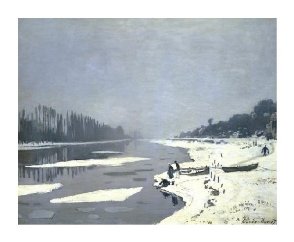Ice floes on the Seine – Claude Monet
Claude Monet captures the misty atmosphere of winter.
The depiction of the river and the background are handled with broad strokes of almost monochome paint; the sky and the water blend together in a harmony of grey tones. A few figures, coming to draw some water with their buckets, painted with brisk, precise brushstrokes, create some life on the river bank and break the impression of stillness.
Ice, floating on the surface of the water, was to become a major theme in his work.
“Ice floes on the Seine at Bougival”, a canvas painted during the winter of 1867-1868, confirms the presence of Monet who came to paint on the spot about 15 kilometres from Paris. Already in 1865 and 1866, Monet had painted snow scenes around Honfleur and in Normandy where Boudin and Jongkind had encouraged him to paint in the open air. In this context, an article in the Journal du Havre of 9 October 1868 can be mentioned “we caught a glimpse of him [Monet], it was winter, during a few days of snow… It was bitterly cold. We noticed a small foot-warmer, then an easel, then a man wrapped up in three cardigans, wearing gloves, his face half frozen: it was Mr Monet, studying an effect of snow. ”
These early snow scenes depicting roads were produced using sharp, vigorous brushstrokes and thick layers of paint. In comparison, the painting “Ice floes on the Seine at Bougival” is more understated : figures and other details in the foreground are captured with lively, precise brushstrokes which bring to life the people coming with their buckets to draw water from the Seine. The portrayal of the river and the background are handled with broad strokes of paint in almost monochrome hues which capture the cloudy, misty atmosphere of the winter landscape and create an impression of stillness and silence.
This painting should be compared to some of Whistler’s paintings that Monet may have seen, in particular “The Frozen Thames” an open air subject painted in 1860 and exhibited in Paris in 1867. The same monochrome fog effects can be found. These two artists had already been able to meet in the workshop of the Swiss painter, Gleyre, established in Paris and training a number of painters including Renoir, Bazille and Sisley, the future impressionists.
In autumn 1870, when Monet and Pissaro went and took refuge in London to escape the Franco-Prussian war, they were able to discover the art of Turner, whose paintings were exhibited in the National Gallery. Monet’s encounter with Turner’s work was to become one of his reference points until the end of his career, mainly with respect to his search for the fleeting effects of atmosphere and light. For example, it is worth mentioning: “Sun Rising through Vapour” by Turner, exhibited in 1852 in the National Gallery can be compared with “Impression Sunrise” painted in 1872-1873, a famous painting at the 1874 exhibition and manifesto for the impressionist movement.


